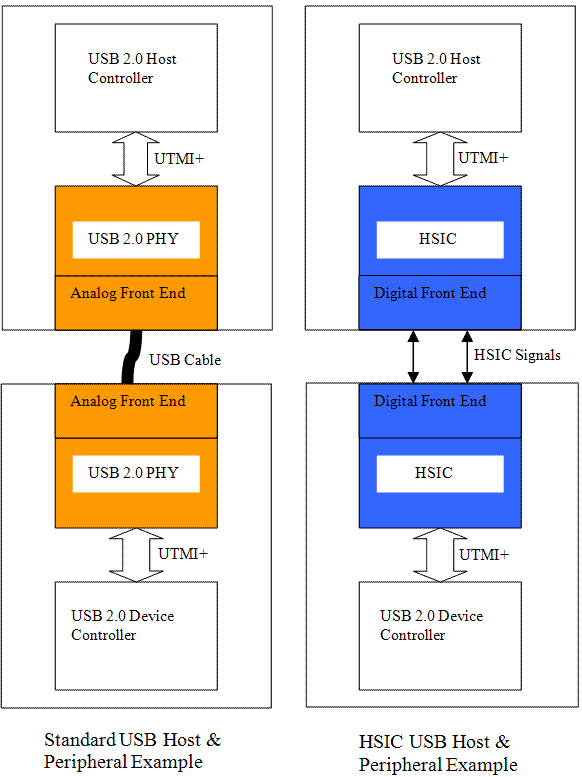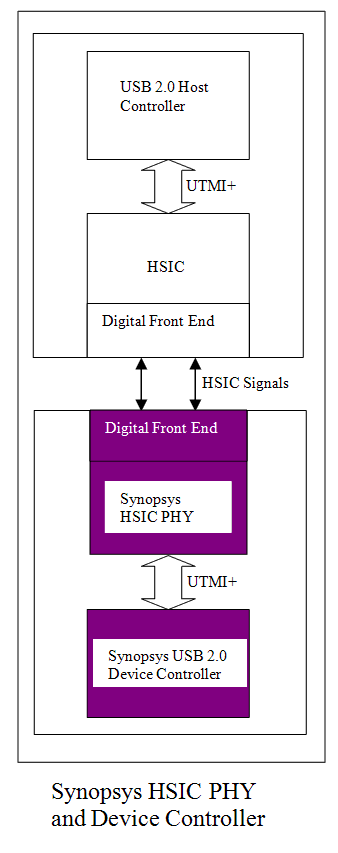USB High Speed Inter-Chip (HSIC) IP: What is it? And why should I use it?
来源: https://www.synopsys.com/dw/dwtb.php?a=hsic_usb2_device
What is HSIC?
HSIC (High-Speed Inter-Chip) is an industry standard for USB chip-to-chip interconnect with a 2-signal (strobe, data) source synchronous serial interface using 240 MHz DDR signaling to provide only high-speed (480 Mbps data rate). No external cables or connectors and hot plug-n-play are supported. There is also no analog transceivers, and hence reduces the complexity, cost, power consumption, and manufacturing risk. Low power can be achieved with 1.2 V LVCMOS signaling levels instead of the 3.3 V signaling requirement. Both data and strobe are bi-directional utilizing NRZI encoding. In addition, HSIC interface is always operated at high speed, 480 Mbps. Hence, no high-speed chirp protocol is needed during enumeration. Finally, HSIC USB is fully compatible with existing USB software stacks and provides all data transfer needs through a single unified USB software stack. For more technical information regarding the requirements to implement a HSIC USB solution, please refer to the High-Speed Inter-Chip USB Electrical Specification, Version 1.0 (a supplement to the USB 2.0 specification.) which is now available online at http://www.usb.org/developers/docs/docs

Why HSIC?
- HSIC replaces I2C
- I2C isn’t fast enough and requires special drivers
- HSIC allows USB Software reuse
- PHY reuse/adaptation of existing PHY technologies
HSIC Device Using Synopsys USB 2.0 Device Controller and HSIC PHY
USB chip-to-chip interconnect can be achieved with the use of both Synopsys device controller and HSIC PHY. It eliminates USB cables and connector connection down to two wires for high speed chip-to-chip communication. It also allows low power high-speed data transfers (480 Mbps) using a source-synchronous serial interface. By eliminating the need of 3.3 V signaling and 5 V short protection logic, Synopsys HSIC PHY can offer approximately up to 50 percent lower power and 75 percent smaller area compared to traditional USB 2.0 PHYs.

USB 2.0 HSIC PHY
- HSIC USB version 1.0 compliance
- HSIC USB Features
- Supports 8/16-bit unidirectional parallel interfaces for HS mode of operation in accordance with the UTMI+ specification
- Implements data recovery from serial data on the HSIC connector
- Implements SYNC/End-of-Packet (EOP) generation and checking
- Implements bit stuffing and unstuffing, and bit-stuffing error detection
- Implements Non Return to Zero Invert (NRZI) encoding and decoding
- Implements bit serialization and deserialization
- Implements holding registers for staging transmit and receive data
- Implements logic to support suspend, sleep, resume, and remote wakeup operations
- General Features
- Occupies small area
- Implements low power dissipation while active, idle, or on standby
- Implements one parallel data interface and clock for high-speed HSIC data transfers
- Provides parameter override bits for optimal yield and interoperability
- Provides on-chip PLL to reduce clock noise and eliminate the need for an external clock generator
- Provides Built-in Self-Test (BIST) circuitry to confirm high-speed operation
- Provides extensive test interface
- Technical Specification
- Small area with approx. 0.18 sq. mm (macro + pads)
- Low power
- HS transmit ~27 mW (typical)
- HS receive ~18 mW (typical)
- Suspend and sleep modes ~4uA
- Supports 12/24/48 MHz clock
- Initial process - TSMC 65LP
- Compatability
- The HSIC PHY uses the same UTMI interface to communicate with Synopsys device controller. Since there is no well defined standard on the UTMI interface for HSIC and we have not tested the HSIC PHY with non-Synopsys device controllers yet, we do not guarantee that the UTMI interface of HSIC PHY would work well with that of non-Synopsys device controllers.
- Availability
- Please contact Synopsys if you are interested in this feature for your USB product.
USB 2.0 Device Controller with HSIC feature
- Configuration
- New device controller configuration option is available to enable HSIC support.
- HSIC logic is implemented through an `ifdef statement. The logic will additionally be controlled by a strap pin.
- Device controller needs to be configured to support unidirectional UTMI PHY interface.
- New device controller configuration option is available to enable HSIC support.
- PHY interface specific
- No new pin is required to interface to Synopsys HSIC PHY for HSIC purposes. Unidirectional UTMI PHY interface is used.
- When the device controller is interfacing to Synopsys HSIC PHY, both the device controller and the PHY are of the understanding not to go through the chirp enumeration steps, but rather go to high-speed idle directly.
- Application Interface/logic
- New strap input pin from Application to enable/disable HSIC support (if the core is already configured to support HSIC through coreConsultant/RapidScript)
- This new strap input pin will not be existed if the device controller is configured not to support HSIC.
- Hardware impact
- Device controller will bypass the Chirp enumeration stage in the chirp_gen_state state machine of udc20_speed_enum module if HSIC feature is supported.
- The bypassing of the chirp enumeration stage will only happen if the associated strap signal is also enabled. If the strap signal is not yet enabled, the core will go through the normal chirp handshake mechanism to support non-HSIC PHY.
- Firmware impact
- No significant change is needed. Supporting high speed falling back to full speed mode is no longer needed when attaching to a HSIC USB host during enumeration because HSIC chip-to-chip interconnect supports high-speed operation only. Hence, a high-speed only device driver is needed.
- Compatability
- The device controller uses the same UTMI interface to communicate with Synopsys HSIC PHY. Since there is no well defined standard on the UTMI interface for HSIC and we have not tested the device controller with non-Synopsys HSIC PHYs yet, we do not guarantee that the UTMI interface of device controller would work well with that of non-Synopsys HSIC PHYs.
- Availability
- Please contact Synopsys if you are interested in this feature for your USB product.
USB High Speed Inter-Chip (HSIC) IP: What is it? And why should I use it?的更多相关文章
- Linux usb 1. 总线简介
文章目录 1. USB 发展历史 1.1 USB 1.0/2.0 1.2 USB 3.0 1.3 速度识别 1.4 OTG 1.5 phy 总线 1.6 传输编码方式 2. 总线拓扑 2.1 Devi ...
- Android 不通过USB数据线调试的方法
在开发Android应用时,通常情况下是通过USB数据线连接设备和计算机,但对于一些需要使用USB设备的应用,这种方法就碰到了麻烦,手机的USB接口已经和外接的USB设备连接,无法再连数据线,此时可以 ...
- USB眼图
/********************************************************************** * USB眼图 * 说明: * 对于USB眼图,并不是很 ...
- USB的挂起和唤醒(Suspend and Resume)【转】
转自:http://m.blog.csdn.net/blog/luckywang1103/25244091 USB协议的第9章讲到USB可见设备状态[Universal Serial Bus Spec ...
- PHP简单爬虫 爬取免费代理ip 一万条
目标站:http://www.xicidaili.com/ 代码: <?php require 'lib/phpQuery.php'; require 'lib/QueryList.php'; ...
- USB各种模式 解释
1.MTP: 通过MTP这种技术,可以把音乐传到手机里.有了U盘功能为什么还要多此一举呢?因为版权问题,MTP可以把权限文件从电脑上导过去:如果只使用手机的U盘功能,把歌的文件拷过去之后,没有权限文件 ...
- USB详解
USB作为一种串行接口,应用日益广泛.如同每个工程设计人员必须掌握I2C,RS232这些接口一样,我们也必须掌握USB.但是USB的接口协议实在有点费解,Linux UCHI驱动作者之一Alan St ...
- 技巧.【转】在虚拟机Vmware中使用HID设备(如USB免驱键盘)
ZC:我的环境:Win7x64.VMware10 ZC:我的处理: ZC: (1).usb.generic.allowHID = "TRUE" (本来就有,将它的位置提前) ZC: ...
- STM32 USB复合设备编写
目的 完成一个CDC + MSC的复合USB设备 可以方便在CDC,MSC,复合设备三者间切换 可移植性强 预备知识 cube中USB只有两个入口. main函数中的MX_USB_DEVICE_Ini ...
随机推荐
- 图论:费用流-SPFA+EK
利用SPFA+EK算法解决费用流问题 例题不够裸,但是还是很有说服力的,这里以Codevs1227的方格取数2为例子来介绍费用流问题 这个题难点在建图上,我感觉以后还要把网络流建模想明白才能下手去做这 ...
- 计算机网络中七层,五层,四层协议;IP 地址子网划分
七层协议: 7 应用层(http) 6 表示层(上层用户可以相互识别的数据:jpg) 5 会话层(不同主机不同线程间的通信) 4 运输层(tcp/ip:传输层提供端到端的透明数据服务)/差错控制和流量 ...
- 【HDU3853】LOOPS [期望DP]
LOOPS Time Limit: 5 Sec Memory Limit: 64 MB[Submit][Status][Discuss] Description Akemi Homura is a ...
- 汕头市队赛 C KMP codeforces B. Image Preview
汕头市队赛题目传送门 codeforces题目传送门 这道题我的做法是 尝试先往左走然后往右走 或者先往右走然后往左走 然后注意一下枚举顺序就okay啦 #include<cstdio> ...
- Django-Django的form表单
注册页面如果用ajax来做,视图views里面判断会很复杂,需要判断各种字段,我们用form来做 form_obj,实例化form_post(form_obj)对象,一定要加上(request.P ...
- HDU3336(KMP + dp)
Count the string Time Limit: 2000/1000 MS (Java/Others) Memory Limit: 32768/32768 K (Java/Others) ...
- 搭建 Linux 下 GitLab 服务器【转】
转自:http://blog.csdn.net/passion_wu128/article/details/8216086 版权声明:本文为博主原创文章,未经博主允许不得转载. 目录(?)[-] 平台 ...
- Google的C++开源代码项目
Google的C++开源代码项目 http://www.open-open.com/lib/view/open1413873531356.html v8 - V8 JavaScript Engin ...
- SuSE Linux10.1 网络设置以及和主机通信end
设置步骤如下: 1.首先判断VMware Bridge Protocol协议是否已经安装.在本地连接的属性中可以查看. 2.虚拟机设置为bridged 3. 虚拟机-Edit-Virtual Netw ...
- python之八大排序方法
一.插入排序 #-*- coding:utf-8 -*- ''' 描述 插入排序的基本操作就是将一个数据插入到已经排好序的有序数据中,从而得到一个新的.个数加一的有序数据,算法适用于少量数据的排序,时 ...
